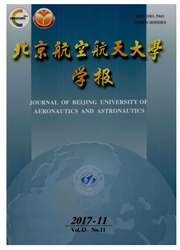

 中文摘要:
中文摘要:
采用周浸实验模拟海水周期浸润环境,中性盐雾实验模拟海洋大气环境,加以恒载荷拉伸应力条件研究了10CrNi3MoV和12MnSiNiCrMo两种结构钢焊接接头的腐蚀特性,并测试分析了其焊接接头各处的动电位极化曲线.通过金相分析研究了两种钢焊缝区、热影响区与母材的显微组织差别.结果表明:两种钢的焊缝区较母材更易发生腐蚀,应力腐蚀断裂位置均位于焊缝区,且焊缝区腐蚀电流密度最大,母材最小;10CrNi3MoV钢焊接接头的耐蚀性能要好于12MnSiNiCrMo钢,在较低和较高应力水平下10CrNi3MoV钢焊接接头的耐应力腐蚀性能也优于12MnSiNiCrMo钢,同时12MnSiNiCrMo钢各区腐蚀电流密度都远大于10CrNi3MoV钢.焊接后不同区域金相组织的差别是造成上述现象的原因,母材区适量的针状铁素体能够保持其强韧性和耐蚀性,焊缝区过量的铁素体则导致其耐蚀性和耐应力腐蚀性能降低.
 英文摘要:
英文摘要:
Corrosion properties of 10CrNi3MoV and 12MnSiNiCrMo welding joints were investigated by alternate immersion test, neutral salt spray test and constant load tensile stress corrosion test. These tests were designed to simulate circulatory soakage of seawater and marine atmosphere respectively. Dynamic polarization curves of the welding joints were tested too. Mierostructures of the weld zone, heat affected zone and base met- al were analyzed by metallographic technique. The results show that the weld zone is more liable to corrosion and more sensitive to fracture. The corrosion current density of weld zone is the biggest while the base metal is the smallest for both two welding joints. The corrosion resistance of 10CrNi3MoV is much better than 12MnSiNiCrMo. When the stress level is comparatively lower or higher, the welding joints of 12MnSiNiCrMo are more susceptible to stress corrosion cracking than 10CrNi3MoV. The corrosion current density of the weld- ing joints of 12MnSiNiCrMo is much bigger than 10CrNi3MoV. Mierostructure differences of different zones are the main reason. Proper amount of acicular ferrite maintains the obdurability corrosion resistance of base met- al, but the resistance to corrosion and stress corrosion cracking is declined by superfluous ferrite in the weld zone.
 同期刊论文项目
同期刊论文项目
 同项目期刊论文
同项目期刊论文
 Effects of sealing process on corrosion resistance and roughness of anodic films of titanium alloy T
Effects of sealing process on corrosion resistance and roughness of anodic films of titanium alloy T Initial Corrosion Processes and Mechanism of 23Co14Ni12Cr3Mo Ultra-high Strength Steel in Salt Spray
Initial Corrosion Processes and Mechanism of 23Co14Ni12Cr3Mo Ultra-high Strength Steel in Salt Spray Effect of Electrochemical Potential and Chloride Concentration on Stress Corrosion Cracking Behavior
Effect of Electrochemical Potential and Chloride Concentration on Stress Corrosion Cracking Behavior Effect of passive film on mechanical properties of martensitic stainless steel 15-5PH in a neutral N
Effect of passive film on mechanical properties of martensitic stainless steel 15-5PH in a neutral N Influence of rust layer on corrosion of ultra-high strength steel 300M submitted to wet-dry cyclic e
Influence of rust layer on corrosion of ultra-high strength steel 300M submitted to wet-dry cyclic e Effect of TiO2 nanostructures on specific capacitance of Al2O3-TiO2 composite film on etched aluminu
Effect of TiO2 nanostructures on specific capacitance of Al2O3-TiO2 composite film on etched aluminu Manifestations in Corrosion Prophase of Ultra-high Strength Steel 30CrMnSiNi2A in Sodium Chloride So
Manifestations in Corrosion Prophase of Ultra-high Strength Steel 30CrMnSiNi2A in Sodium Chloride So Effects of hydrogen on stress corrosion cracking behavior of ultra-high strength steel 23Co14Ni12Cr3
Effects of hydrogen on stress corrosion cracking behavior of ultra-high strength steel 23Co14Ni12Cr3 SCC investigation of low alloy ultra-high strength steel 30CrMnSiNi2A in 3.5wt% NaCl solution by slo
SCC investigation of low alloy ultra-high strength steel 30CrMnSiNi2A in 3.5wt% NaCl solution by slo Influence of ZrSi Molar Ratio on Structure, Morphology and Corrosion Resistance of Organosilane Coat
Influence of ZrSi Molar Ratio on Structure, Morphology and Corrosion Resistance of Organosilane Coat 期刊信息
期刊信息
